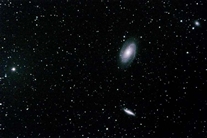m081_52deg_ed80f075_20d_nr_dark_1x20miniso1600_ps-curve_pe-despekmed1.jpg
m081_52deg_ed80f075_20d_nr+dark_1x20miniso1600_ps-curve_pe-despekmed1.jpg
(m081_52deg_ed80f075_20d_nr+dark_1x20miniso1600_ps-curve_pe-despekmed1.jpg)
M81 and M82
Messier 82
Irregular Galaxy M82 (NGC 3034), type Ir-II, in Ursa Major
Cigar Galaxy
Right Ascension 09 : 55.8 (h:m)
Declination +69 : 41 (deg:m)
Distance 12000 (kly)
Visual Brightness 8.4 (mag)
Apparent Dimension 9x4 (arc min)
Discovered by Johann Elert Bode in 1774.
Excerpt from seds.org:
Messier 82 (M82, NGC 3034) is a remarkable galaxy of peculiar type in constellation Ursa Major. It is usually classified as irregular, though probably a distorted disk galaxy, and famous for its heavy star-forming activity, thus a prototype member of the class of starbursting galaxies.
Forming a most conspicuous physical pair with its neighbor, M81 (THE showpiece galaxies for many Northern hemispherers), this galaxy is the prototype of an irregular of the second type, i.e. a "disk" irregular. Its core seems to have suffered dramatically from a semi-recent close encounter with M81, being in a heavy starburst and displaying conspicuous dark lanes. This turbulent explosive gas flow is also a strong source of radio noise, discovered by Henbury Brown in 1953. The radio source was first called Ursa Major A (strongest radio source in UMa) and cataloged as 3C 231 in the Third Cambridge Catalogue of Radio Sources.
In the infrared light, M82 is the brightest galaxy in the sky; it exhibits a so-called infrared excess (it is much brighter at infrared wavelengths than in the visible part of the spectrum). This behaviour can also be observed for the companion of M51, NGC 5195, and the peculiar galaxy NGC 5128 (Centaurus A). The visual appearance is that of a silvery sliver, as John Mallas decribed it.
Recently, over 100 freshly-formed (young) globular clusters have been discovered with the Hubble Space Telescope. Their formation is probably another effect triggered by the encounter with M81. It was estimated that the most recent tidal encounter occurred between about 50 and several 100 million years ago: STScI's most recent number was 600 million years, when the 100-million-year-long period of heavier interaction began.
As a member of the M81 group, M82 is 12 million light years distant.
M82 was discovered on December 31, 1774 by Johann Elert Bode together with M81; he described it as a "nebulous patch", about 0.75 deg away from M81, which "is very pale and of elongated shape," and cataloged it as No. 18 in his catalog. Pierre Méchain independently rediscovered both galaxies as nebulous patches in August 1779 and reported them to Charles Messier, who added them to his catalog after his position measurement on February 9, 1781.
M82 belongs to those few Messier objects which have been assigned a Herschel number, H IV.79, based on an observation of September 30, 1802, while William Herschel usually carefully avoided to give his numbers to Messier objects.
William Parsons, the Third Earl of Rosse, was the first to remark on the dark dust lanes and patches visible in the central part of M82.
Halton Arp has included M82 as No. 337 in his Catalogue of Peculiar Galaxies.
One false and one true supernova have been reported in M82 so far:
Lebofsky, Rieke, and Kailey reported the discovery of a supernova, 1986D, which should have occurred in M82, and is e.g. listed in Kenneth Glyn Jones' book. However, this "SN" turned out to be a false alarm. Instead, a slightly variable 2-micrometer source had fooled the discoverers.
Supernova 2004am was discovered lately on images taken at Lick Observatory on November 21, 2003, when it was at mag 17.0.
